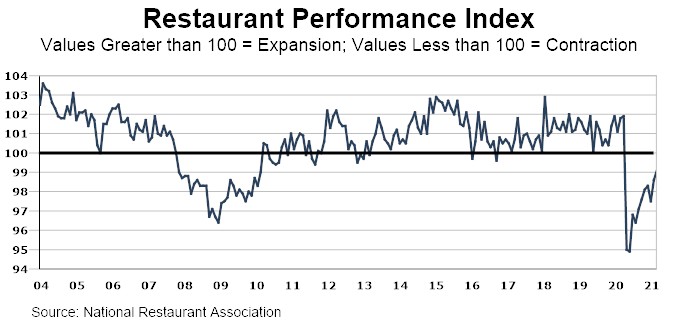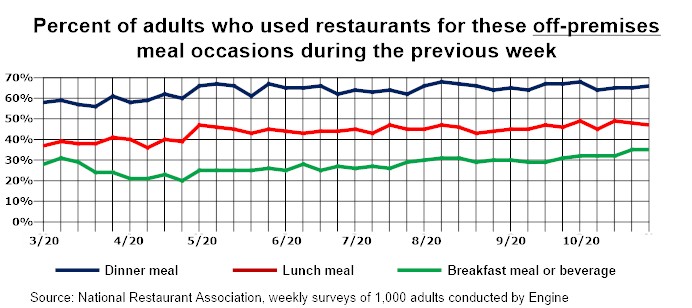17 minutes
Jump To:
- Initial Challenges
- The Art of Finding New Customers
- Keep Your Surveys Short and Simple
- Establishing Employee Loyalty
- Using Customer Surveys
- Take Social Responsibility
- Online Ordering for Additional Sales Growth
- Creating Your Effective New Website
- Creating a Successful Social Media Presence
Initial Challenges
All restaurants, regardless of their size, must first address a number of major challenges to achieve success. In no particular order, let's briefly list these challenges below:
Procuring Capital
It's essential to have enough capital to fully establish the business. The best plan is to have enough principal put aside to run the restaurant for at least one year along with the financial resources to handle unexpected costs and increases.
Location
One of the most important factors for future success is where you lease your restaurant space. This is a critical area where you need to spend considerable time and energy for extensive research, a blend of marketing surveys and interviews with key local restauranteurs and prospective customers.
Effective Management
Ensure you have all the tools to efficiently analyze the business to ensure it functions profitably. This entails keeping a close watch on the day-to-day operations.
Unique Selling Proposition (USP)
Every business needs a singular inspiration. In short, why should someone choose your restaurant over your many competitors? The USP should be strong enough that it stays with your customers long after the meal and brings them back for numerous return visits, establishing an emotional connection.
Strategic Marketing
Start with a marketing plan and follow it. Create an effective website and a high-quality Facebook page. You can also embed a survey or form into your website to collect much needed feedback. Build your brand identity. Stay on top of trends with periodic customer satisfaction surveys.
A Focus on The Menu
Ensure it thoroughly aligns with your USP. Be confident the dishes can be easily understood and are competitively priced.
Hiring & Training Your Staff
Never to be taken for granted, the best face to the customer ensures increased sales, repeat visits, positive word-of-mouth and online reviews. Recruiting and keeping great employees is not an easy task but is essential to your future longevity.
Outstanding Customer Service
Even if you've executed all of the abovementioned issues satisfactorily, there is no chance for short or long-term success if the service is inferior. The kitchen must be run efficiently and the entire staff must be consistently pleasant and supportive of every customer walking into the establishment.

The Art of Finding New Customers
Most restauranteurs subscribe to three basic tenets for acquiring new customers:
1. Closely study the most successful restaurants in your town.
Due to social media, you can now follow the stars alongside the restaurant name and read what customers say about their food, service, ambience, etc. Do they reward frequent customers with an incentive? Also, pay attention to the effort shown in the quality of their website and Facebook page. Now imitate and improve upon their "secret formula" as much as possible! After making the necessary tweaks, watch your Yelp customer reviews to see if they noticed all your hard work by rewarding you with significantly higher ratings. If not, it may be time for executing a round of customer surveys.

A busy restaurant in Glasgow, UK, Source: Euan Cameron
2. Locate and entice prospects to try your restaurant.
Study the age groups and gender of your current customer base. Based on your location, determine the distance these customers travel today to enjoy your menu. If it's a busy city, you probably experience a lot of foot traffic. However, if you're in a suburban strip mall, you need to be comfortable with the mileage range driven by your lunch and dinner crowd. Keep in mind that your lunch clientele—those people with perhaps no more than 30-45 minutes free for a quick bite to eat during their work day—may be quite different from those who visit your restaurant for dinner. Now use Facebook advertising to select these demographics and see how many fit these attributes. The next step is to determine your advertising budget and create a special offer to attract them. Design and release the ad. Add a Quick Response (QR) code and collect email addresses so you can send discount offers or incentives later.
3. Keep close track of every customer who redeems the offer.
Measure the return on investment in order to either repeat the same offer or make the necessary adjustments to meet your success criteria.
4. Build a customer loyalty database so you can periodically market your "specials" to an ever-growing audience.
Be sure to survey the customer database on a semi-annual basis to uncover ongoing issues and potential new dining trends. In order to opt-in and take advantage of these offers, customers must leave a review on your Facebook page which will, in turn, capture their email addresses, locations, age groups, gender, and general comments for your marketing database. If maintained properly, this database will become one of the major assets of your business.
Using Customer Surveys
Employing quick and easy-to-understand customer surveys will provide you with a treasure trove of information about your menu, food, customer service, and the overall ambience of your restaurant. This data will serve as the foundation for making future modifications to the menu, the place settings, the service, and the marketing of the restaurant to attract new customers.
There are a number of simple rules to follow when creating the survey:
1. Avoid Yes/No Questions Only which give you no insight into the thoughts of the respondents. This question type should always be accompanied by "Why?" with a text box to enable the respondent to explain his or her opinion.
2. Ask Open-Ended Questions which elicit unvarnished customer comments. Use this approach sparingly as overuse will defeat the purpose, i.e., the user will just leave the text areas blank if it is overdone. (Example: "Why did you choose our restaurant for the event?")
3. Keep the Questions Simple with only one idea at a time. (Example: "Was the music too loud?" followed by choices of "Much Too Loud", "Loud", "Just Fine", "Sorry, No Opinion".)
4. Avoid Biased Questions which will put the survey results in doubt. (Example: "Did you enjoy our great wait staff tonight?" makes the assumption they were "great".)
5. Try a Net Promoter Score Question (NPS) to help you gather key data on critical issues. (Example: "On a scale of 1-10, how likely would you recommend our restaurant to a friend?") These responses lend themselves to future analytical graphs and charts.
6. Test the Survey before you forward it to your targeted audience. Ask your partner(s) and staff to review the survey to ensure it is devoid of grammatical errors and none of the questions might be the source for potential confusion.
It is always a good idea to survey your customer base at best every 3-6 months and, at the least, no longer than 6 months. Once the results are captured, you should see where your restaurant surpasses expectations and where there is a clear need for improvement. It is always a good idea to follow-up with an email thanking everyone for their much-appreciated input and, if necessary, the positive steps taken to address any across-the-board issues.
Don't miss out on integrating brief customer satisfaction surveys on your invoices or receipts in traditional POS systems or an online sales system like QuickBooks or Sage. Try such incentives like "Buy 2, Get 1" or "Free Dessert" to entice high response rates.
Potential Survey Questions
There are undoubtedly a never-ending number of questions you would probably like to ask your customers on a survey. There is so much you need to learn to better understand customer perceptions and problems related to your business. There are, however, some fundamental subjects that deserve your initial attention.
1. Key Customer Information
"How often do you dine at a restaurant in a given week?" (More than 3 times/Up to 3 times/Once a week/Rarely)
"How often do you dine at our restaurant?"
"Was this your first time at our restaurant?"
"How did you hear about us?"
"How likely is it that you would come back?" (Very Likely/Likely/Unlikely/Very Unlikely)
"Do you find our restaurant to be family-friendly?" (Yes/No and Explain)
"Are our hours convenient?" (Yes/No and Explain)
"How far did you travel to visit us today?"
"The waiting time to be seated was. . ." (About What I Expected/A Little Longer than I Expected/Much Longer Than I Expected)
"If [TBD] was an option, would you try it out? (Yes/No and Explain)
"If you use a wheelchair, did you find the staff and facilities accommodating? (Yes/No and Explain)
"Were the seats comfortable?" (Yes/No and Explain)
"Was the music volume to your liking?" (Yes/No and Explain)
"If you ordered online or by phone, how quickly did your food arrive?"
"If you ordered online or by phone, did the food appear and taste fresh when you arrived?" (Yes/No and Explain)
2. Food Offering
"What do you like the most about our menu?"
"What do you dislike the most about our menu?"
"How would you rate the value of our food?" Rate from 1 (poor value) to 5 (great value)
"Thinking about value for money, how would you describe the food in general?" (Good Value/Reasonable/Poor and Explain)
"Is there anything you'd want to see on the menu that's missing?" (Yes/No and Explain)
"Do you find our menu has something for everyone?" (Yes/No and Explain)
"How would you rate the options on our menu?" Too few/Just right/Too many
"If you have dietary restrictions, were you accommodated well today?" (Yes/No and Explain)
3. Libations
"Were you pleased with our drink offerings?" (Yes/No and Explain)
"What drinks would you like to see added to the menu?"
4. Service
""Did the wait staff meet your needs?" (Yes/No and Explain)
"Who was your server today?"
"Was the service friendly and welcoming?" (Yes/No and Explain)
"If there were any issues, did your server handle them well?" (Yes/No and Explain)
5. Speed
"How did you feel about the speed of tonight's service?"
"Did the food come out fast enough?" (Yes/No and Explain)
6. Overall Appearance
"Please rate the cleanliness of the restaurant".
"Were the bathrooms and other facilities clean? (Yes/No and Explain)
7. Paying the Bill
"Was our checkout system efficient?" (Yes/No and Explain)
"Did you use any of our discounts or special offers?" (Yes/No and Explain)
"Did you enjoy using our handheld checkout device and/or kiosk?" (Yes/No and Explain)
8. Growth Potential
"How likely is it that you would recommend (restaurant name here) to a friend?" (Very Likely/Likely/Unlikely/Very Unlikely)
Keep Your Surveys Short and Simple
Now that we've established the survey questions that are intrinsic to your restaurant, it should be noted that the best surveys are usually short (no more than five questions) and tend to be completed in under 5-10 minutes. As you probably have noticed when you've been asked to take part in fairly long questionnaires, fatigue often sets in and there is a tendency to either prematurely abandon the document or just fill in the blanks without thinking of a well-meaning response. Most research professionals believe you should only pose questions that you are confident can be answered immediately. No need to rush. Everything else can be asked at a later date.
Finally, fight complacency by sending out surveys periodically (3-6 months) to capture new feedback.
Looking for the right restaurant survey template? Visit https://www.surveyol.com/surveytemplates for assistance.
Establishing Employee Loyalty
There are a number of proven methods to ensure your best employees stay and flourish at your restaurant. Their success is critical to the success of your business.
1. Training
No one can succeed unless someone is willing to teach them how to perform and excel at their position. The most successful restaurants have someone specifically assigned to train, teach and coach all employees. This individual spends perhaps 10%-20% of his or her time focused exclusively on the staff, giving individualized attention to their needs.
2. Wages
It's been proven time and time again that increasing labor costs—in short, being very competitive with other restaurants in your area—has a significant impact on employee loyalty, retention, and yes, even productivity.
3. Expanding Benefits
Once you have addressed the wages issue, many of your employees may still be unable to cover healthcare costs and save anything for the future. Some restaurants have started offering their full-time employees healthcare, profit-sharing, and retirement plans. While this undoubtedly increases upfront management costs, it will reap its rewards with your best employees keeping their eyes on unwarranted restaurant costs, sharing their thoughts on how to increase sales, and staying put.
4. Opportunities for Advancement
When employees experience roadblocks for promotion, the prospect for retaining them is highly unlikely. When you offer your best employees incentives for internal promotions, many will opt to stay and work hard to achieve this all-important sign of recognition and the possibility for an increase in salary. As mentioned above, maintaining high morale amongst your achievers is always better than living with a revolving door and constantly training new employees.
5. Avoid Overworking Your Employees
It's a tough industry that sometimes requires an extraordinary number of hours. Some will accept it as the norm, while others will quit and go elsewhere. If you can limit the positions to 40 hours per week with generous vacation time, many employees will be appreciative and not look anywhere else. It is advantageous to establish an online scheduling system that will ensure your staff has the prospect of recovering from the occasional 40+ hour work week.
6. Employee Recognition
Be sure to recognize those employees who go over and beyond your expectations. Sometimes a simple "thank you" goes a long way. Encourage positive relationships between your staff since it ensures everyone pulls together with overall loyalty to the restaurant. Finally, make sure everyone knows when someone has stepped up. It's the recognition from management that many people crave and often never receive.
7. Don't Forget Periodic Surveys
While you may think you are fully aware of issues in your restaurant, the brief Employee Satisfaction Survey Template, anonymously completed, will serve as the best way to uncover issues festering below the surface.
Taking Social Responsibility
One of the most important marketing and operations program is to embrace a social responsibility mindset. Savvy customers expect the restaurants they regularly frequent to support the betterment of the community and the environment. Most studies indicate that 66% of the world's consumers, especially Millennials, prefer shopping or dining at establishments that give back to society.
In light of such a critical decision, you might want to consider the following:
1. Support causes important to your staff.
2. Select a charity or special cause (e.g., the local police or fire department, world hunger, the Red Cross, Habitat for Humanity, etc.) that you can support year-round.
3. Support local education issues that ultimately benefit the children of your staff and your customers.
4. Support the community when it experiences natural disasters (e.g., blizzards, hurricanes, tornadoes). When your restaurant empathetically responds (i.e., raising emergency funds, offering free coffee, staying open beyond normal hours), it attracts positive press and solidifies your place in the community.
5. Host a charity event or donate food or refreshments to a special event. Be sure to survey the attendees to ensure future success.
6. Recruit staff members for a charity walk/run or a local community project.
7. Source only locally grown ingredients and humanely-raised meats and aggressively promote this passion on your menu, website, and Facebook page.
Everyone wins. Your customer base feels great every time they view the advocate signage upon entering your restaurant. The charity or cause benefits by receiving much-needed funds. And, as a by-product of a social conscience, you experience increased customer loyalty and income.
There is one note of caution: You need to be sincere. If you're doing it to just drum up business or because "you have to do it," your efforts may strike some as fake and self-serving. Ultimately, your repeated advocacy for a cause will win over your staff, your customers, and the community. Once your customers realize you are a socially responsible force in the neighborhood, they will unequivocally support you and tell their friends about you. The greatest benefit of all is that you will be inordinately proud of your business.
Online Ordering for Additional Sales Growth
Capturing online orders from smartphones and computers has become even more critical to a restaurant's success during the harsh pandemic. The best online ordering systems offer order tracking, simple analytics reporting, and a notification feature.
The good news is that even small local restaurants can now take advantage of these sales opportunities. Some online ordering companies charge restaurants a monthly subscription fee (ranging from $30 to $199); others retain a commission on all orders placed through their system (starting at 5% and going up to 35%).
The top three restaurant online ordering systems on the market today are featured below:
GrubHub: Greatest reach in this space. Available in 4,000+ US cities and London, UK. Supports multiple payment methods. The app is free but there is a $9.99 per month fee option to let the user enjoy free delivery. The app enables the user to search by cuisine or location, quickly order food from the menu, and track the order without any extra charges.
DoorDash: Available in 4,000+ US, Canada and Australia. "DashPass" option or $9.99 per month fee option lets the user save on delivery charges. Easy-to-use options track delivery, pick-up or schedule deliveries for the most convenient times. The app includes a "Yum Score" that allows the user to rate food quality and how well the restaurant worked with DoorDash to get the food out quickly.
Uber Eats: Available in 500+ cities in 24 countries. 15% service fee of order total. "Eats Pass" option for $9.99 per month lets the user enjoy free delivery with an additional 5% discount on orders over $15. Integrated with Uber is some cities. The app enables users to place an order for immediate or scheduled delivery and track the order in real-time, just like booking an Uber ride. Payment can either be accomplished with a credit card or via credits on the user's Uber account.
How do you choose the best platform to fit your unique needs? It's always a prudent to read as many consumer reviews as possible and network with fellow restauranteurs to reach a consensus. As you may have already discovered, it's a mixed bag. Many restaurants find online ordering break-even at best while others have found a way to make this a profitable venture.
Once the investment is made and you're up-and-running with the new system, be sure to survey your customers to ensure they are satisfied.
Creating Your Effective New Website
There are a number of key issues you need to address to make the website productive. It should serve as the primary communication device to reach new and returning customers. All key decisions as you create the site should support this focus.
1. First-timers are shopping for a new place to eat in your town or city.
They may be comparing up to five different websites and their menus to reach a verdict. Not surprisingly, most of your audience will be viewing the website on a mobile device so keep this in mind as you design it. Make it easy for the potential diner to contact you (if they have any questions or concerns) with easily accessible driving directions.
2. Returning customers won't spend a lot of time on the website.
They'll simply need quick access to your food menu, directions, and contact information to make a reservation (if applicable). Please be sure it's readily available, not buried behind multiple clicks.
3. Pay attention to the images shown.
High quality photography is a must. If it's done correctly, the images will convey the ambience of your restaurant, along with the popular entrees, staff, and overall style. If your exterior shows well, prominently feature it on the home page. If you feel more comfortable with interior shots, then show your dining tables, bar (if applicable), and staff. Many restauranteurs have also chosen to present brief videos of their store front with a focus food preparation.
4. Most of your visitors will be interested in your menu so make it easy to view.
Displaying professional photos of your signature dishes is an effective way to introduce the menu. A few basic rules: If possible, present your menu on one page rather than breaking your offering down into specialties. This prevents multiple clicks and user frustration. One final note: While your physical menu may not offer food images, it is probably advantageous to show them on your online menu. It's all part of the shopping experience.
5. Differentiation is a necessity on the web.
Clearly write about your restaurant, its food offering and overall mission. You only have a few seconds to get their attention. If it effectively separates you from your competitors, be sure to share when you were founded (and the story behind it), where the majority of the menu offerings are sourced, how it's specially prepared, who your head chef is, even details about your core team. Strong imagery and text are an unbeatable combination.
6. Make it Easy to Find Your Location, Hours, and Contact Information.
It seems so basic but many restaurants either do not prominently display this data or have chosen to hide it on specific pages within the website. Proudly show it on your home page and be sure to link your address to Google Maps and a special telephone link so that everything can be accomplished in just one click.
7. Sign Up for Google Analytics (GA) to judge how your website is performing.
GA (it's free) will tell you how many visitors you've attracted, how many bounced back to the search engine when they landed on your home page, the average time spent on your site, what the visitors are viewing, etc.
8. DIY or Hire an Outside Agency.
Some restauranteurs prefer to be in total control of their website, from creation to release to periodic maintenance. There are relatively inexpensive "off the shelf" websites that can be purchased so you can be online in just a few hours. Others prefer custom websites which require professional web design agencies. It's a difficult decision. You must decide whether you simply need a web presence or one that completely does justice to your business. It should be noted that a web design agency will also help you develop an online market strategy that will complement other advertising efforts to build your brand.
9. Getting Feedback.
It's important to learn as much as possible about the effectiveness of your website and the specific pages within it. You can either survey your website visitors via email or embed a survey. These periodic surveys will provide you with indispensable feedback to improve your website.
Creating a Successful Social Media Presence
Do not neglect social media in generating and maintaining interest in your restaurant. Be sure both new and existing customers can find you on Facebook, Yelp, Twitter and Foursquare. It's important to approach these branding opportunities with the same mindset given to your website. Make them as inviting as possible with superior content—outstanding images and text—that will drive these visitors to your restaurant. Use these platforms to communicate upcoming specials, events, menu changes—essentially anything to reward these visitors with incentives to follow you.
About the author:






